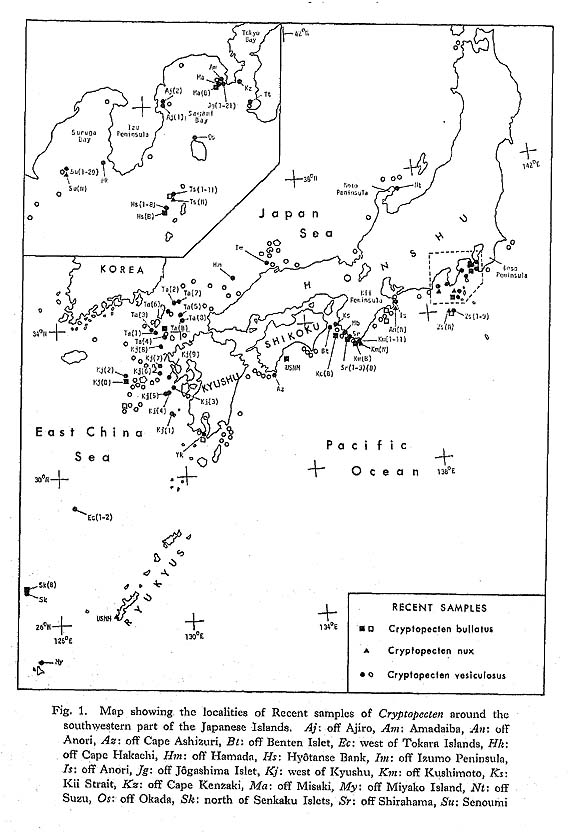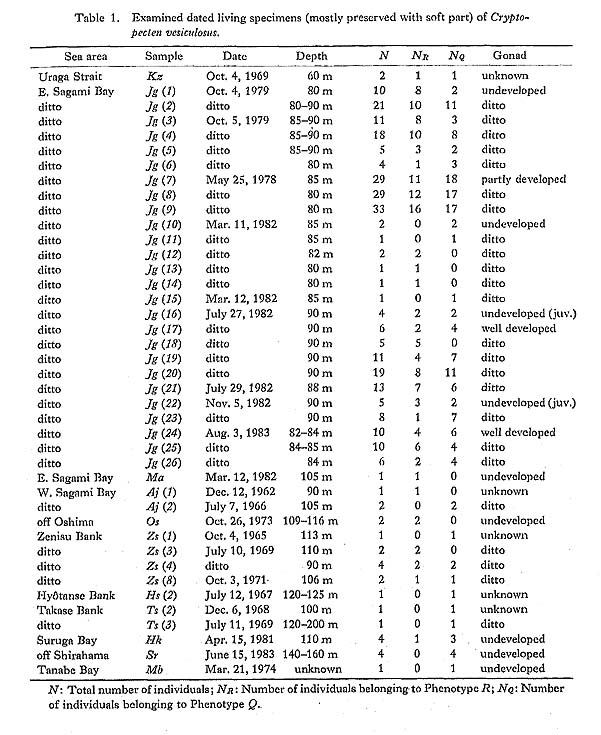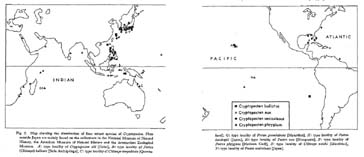CHAPTER 3
Geographic Distribution and Habitat of Living Cryptopecten
|
Cryptopecten is represented by comparatively small and sometimes inconspicuous species, whose distribution and ecology have yet to be satisfactorily studied. It has been found mainly on sublittoral and upper bathyal sandy bottoms by scientists and fishermen using dredging and trawling techniques. It is primarily an Indo-Pacific genus, though there is an uncommon but authentic species in the Mexican Gulf region. Aside from Propeamussium, Palliolum and some other genera with thin and translucent shells, Cryptopecten is generally regarded as a pectinacean genus adapted to most deep-water environments. In Japanese waters the occurrence of living Cryptopecten is restricted to sea areas under the influence of the Kuroshio warm current and its branch, the Tsushima warm current; there is no record of any representative species in Oyashio cold current areas or in semi-closed embayments (Fig. 1).
Much of our present knowledge about the distribution of outer sublittoral and upper bathyal benthic molluscs around the Japanese Islands derives from the "survey of the continental shelf bordering Japan", which was carried out during the years 1922-1930 largely by the R/V Sôyô-maru I. A part of the dredged bivalve shells were studied by Habe (1958), and all the organisms, which had hitherto been identified and recorded, were compiled in a comprehensive list by Horikoshi et al. (1982) with information about precise location, depth and bottom character. There were 658 Sôyô-maru I stations over an area covering the greater part of the continental shelf around the main part of the Japanese Islands (except for Hokkaido and Ryukyu Islands); "Cryptopecten tissotii" [=C. bullatus] and C. vesiculosus were recorded at 5 and 87 stations, respectively (Fig. 1). Although I have observed only a part of this enormous collection, the record has been useful in establishing the horizontal and bathymetric distribution of these species. Dall, Bartsch and Rehder (1938) originally recorded Cryptopecten alli [=C. bullatus] from three stations of the U. S. Bureau of Fisheries'R/V Albatross around the Hawaiian Islands. The holotype of C. alli (USNM 173194), probably a solitary living specimen at that time, was collected from the coarse-grained sand and rocky bottom at 238-252 fathoms off the south coast of Oahu Island. Several lots of dead shells subsequently collected from the seas around Hawaii and the Philippines, deposited mainly in the National Museum of Natural History, Washington, D. C. and the Bernice P. Bishop Museum, Honolulu, were also from upper bathyal bottoms of similar or somewhat lesser depth. Dautzenberg and Bavay (1912) originally described a conjoined (probably living) specimen of Cryptopecten bullatus from Siboga Station 105 (275 m) off Sulu Archipelago, Philippines. C. bullatus seems to be distributed mainly in the central and northwest Pacific, but there is an aberrant occurrence of some dead shells (USNM 773983) collected from the top of Nasca Ridge (228 m) about 1,200 km west of north Chile. Judging from the geographical position and somewhat specialized morphology, this sample may represent a local population semi-isolated in the region of Ekman's "East Pacific barrier" (Figs. 2 and 26). C. bullatus is actually distributed in the lower sublittoral and upper bathyal waters off the Pacific and East China Sea coasts of southwest Japan, for it is evidently conspecific with what Japanese malacologists have traditionally called "Cryptopecten tissotii (Ber-nardi)".* As shown in Table 2, several young specimens with well-developed reproductive glands were collected from sandy bottom (140-180m) off the coast of Shirahama, Kii Peninsula (sample Sr (1-3) (B)). According to Habe (1958) and Horikoshi et al. (1982), the present species was recorded from two stations (132 m and 183 m) off the eastern coast of Kii Peninsula and three stations (155 m, 219 m and 549 m) off the western coast of Kyushu. The examined material includes several specimens from Tsushima Strait (Sample Ta. (B)), but, so far as I am aware, C. bullatus does not seem to live in the Japan Sea.
As was described by Okutani (1972), C. bullatus occurs commonly on three submarine banks, called Zenisu, Hyôtanse and Takase, to the west of the Izu-shichitô Islands. According to him, living individuals of this species were collected by the R/V Sôyô II at six stations (Samples Hs (B), etc.) ranging from 130 to 180-220 (or 160-260) meters in depth. The following living molluscs were said to be accompanied by C. bullatus in one or more dredge sample: Gaza sericate Kira, Galeoastrea guttata (Adams), Serpulorbis xenophorus Habe, Sassia semitorta (Kuroda and Habe), Tritonoranella ranelloides (Reeve), Tucetona shinkuroensis Hatai, Niino and Kotaka, Nipponolimopsis decussata (Adams), Modiolus margaritaceus (Nomura and Hatai), Chlamys princessae Kuroda and Habe, Polynemamussium intuscostatum (Yokoyama), Lima fujitai Oyama, Lima profunda. Masa-hito, Kuroda and Habe, Limatula (Stabilima) japonica (Adams), Meiocardia tetragona (Adams and Reeve), Chama (Amphicama) argentata Kuroda and Habe. On the same submarine banks Cryptopecten vesiculosus are common as well. According to Okutani (1972), living individuals of C. vesiculosus were collected at twelve stations (Samples Zs (1, 3, 4, 8), Hs (2), Ts (2,3, 5)) ranging from 84 to 200 meters (see Table 1, Text-fig. 3). Dead shells of C. vesiculosus and C. bullatus were often found together in dredge samples, but living individuals of the two species were riot found in association except for one sample (Station D52 by Okutani, 1972). The bathymetric ranges of the two species evidently overlap. Nevertheless, certain segregation between the populations of the two species is suggested. Taking bathymetric data in other sea areas around Japan into consideration, C. vesiculosus seems in general to prefer somewhat shallower bottom than C. bullatus. Okutani (1972) recorded the following living molluscs together with C. vesiculosus in one or more dredge samples: Emarginula foveolata fujitai Habe, Gaza sericata Kira, Astralium okamotoi Kuroda and Habe, Galeoastraea girgylla (Reeve), Galeoastraea guttata (Adams), Tritonoranella ranelloides (Reeve), Biplex hirasei Sowerby, Chicoreus saltatrix Kuroda, Phos hirasei Sowerby, Tucetona shinkuroensis Hatai, Niino and Kotaka, Samacar pacifica (Nomura and Zinbo), Chlamys princessae Kuroda and Habe, Polynemamussium intuscostatum (Yokoyama), Lima fujitai Oyama, Meiocardia tetragona (Adams and Reeve), Chama (Amphicama) argentata Kuroda and Habe, Vasti-cardium wenicola (Reeve), Frigidocardium eos (Kuroda), Venus (Ventricolaria) toreuma Gould. The substrata of these submarine banks are, as described by Niino (1935, 1952), mainly gravel or coarse-grained sand with shell and coral fragments. Most of the above-listed molluscs seem to be epifaunal species inhabiting coarse-grained substrates of this sort. Cryptopecten vesiculosus is a well-known and common species in southwest Japan. It is distributed not only off the Pacific coast of southwest Japan (35°N and south) and in the East China Sea but also off the Japan Sea coast of Honshu (41°N and south) through Tsushima Strait (Kuroda and Habe, 1952) (Fig. 1). According to the records of the R/V S ô y ô I (Habe, 1958; Horikoshi et al., 1982), C. vesiculosus distributes predominantly on the continental shelf and slope around the southwestern half of the main part of the Japanese Islands (Honshu, Shikoku and Kyushu) from Boso Peninsula to Noto Peninsula. In the northern part of Honshu, however, this species was recorded only at two stations in the western part of Tsugaru Strait. The bathymetric range is said to be 51-582 m off the Pacific coast, 73-340 m off the East China Sea coast, and 73-406 m off the Japan Sea coast. The locations noted in these records are reliable but based mainly on the occurrence of dead shells including immature individuals and fragments, and the habitats of adult individuals joining reproductive activity may be restricted to somewhat narrower geographic and bathymetric ranges. Off the western coast ofMiura Peninsula, for example, immature shells and, sometimes, living infant individuals can be collected from depths as shallow as 40 meters. On one occasion, near Cape Nagasaki-hana in Kagoshima Prefecture I obtained a few immature valves washed ashore (Sample Yk). So far as I am aware, the occurrence of living adult individuals is almost entirely restricted to the lower sublittoral zone between 60 and 200 meters. Dautzenberg and Bavay (1912), on the Siboga Expedition, recorded C. vesiculosus from five stations in Indonesia. According to Dr. Dijkstra's personal communication (June 22, 1983) supported by photographs of the specimens in question, however, all of them undoubtedly belong to C. nux. The southern limit of main distribution of C. vesiculosus probably lies between Ryukyus and Formosa. The examined samples, therefore, seem to cover roughly the known distribution of this species. In the eastern part of Sagami Bay near the southwestern coast of Miura Peninsula, C. vesiculosus is one of the commonest bivalves on sandy substrates (Biological Laboratory, Imperial Household, 1971; etc.). After a number of dredge trials on board the R/V Rinkai of the Misaki Marine Biological Laboratory, the University of Tokyo, I succeeded in determining the habitat of adult individuals and collected as many as 260 living specimens, almost all from the same station, about 2.5 km west of the western end of J ô gashima Islet (Table 1). In this sea area the periphery of continental shelf is only 100 meters deep, probably owing to intermittent upheaval. C. vesiculosus dwells near the shelf periphery where rich nutrition seems to be supplied by upwelling water. The following living molluscs were found together in one or more dredge samples: Emarginula fragilis Yoko-yama, Enidajaponica Adams, Turcica coreensis Pease, Tristichotrochus haliarchus (Melvill), Tristichotrochus acukatus (Sowerby), Galeoastraea modesta (Reeve), Serpulorbis xeno-phorus Habe, Balcis martinii (Adams), Xenophora japonica Kuroda and Habe, Polinices sagamiensis Pilsbry, Tritonoranella ranelloides (Reeve) (only the phenotype with large nodes), Reticutriton tenuiliratus (Lischke), Charonia sauliae macilenta Kuroda and Habe, Ocenebrellus aduncus (Sowerby), Pteropurpura vespertilis Kuroda, Fusinus perplexus perplexus (Adams), Granulifusus sp., Phos hirasei Sowerby, Endemoconus sieboldii (Reeve), Glycymeris rotunda (Dunker), Crenulilimopsis oblonga (Adams), Chlamys lemniscata (Reeve), Polynemamussium intuscostatum (Yokoyama), Limafujitai Oyama, Neopycnodonte musashiana (Yokoyama), Megacardia ferruginosa (Adams and Reeve), Meiocardia tetragona (Adams and Reeve), Nemocardium (Keenaea) samarangae (Makiyama), Frigidocardium eos (Kuroda), Pitar (Pitarina) affine (Gmelin), Venus (Ventricolaria) foveolata (Sowerby), Pandora (Pandorella) wardiana (Adams), Cuspidaria chinensis (Griffith and Pidgeon).
At this station C. vesiculosus is the most dominant molluscan species, but a reddish terebratellid brachiopod, Laqueus rubellus (Sowerby) is found in greater abundance. Crenulilimopsis oblonga, Lima fujitai, Megacardia ferruginosa, Twcica coreensis and Tritonoranella ranelloides are also quite abundant. The substratum at this station is also coarse-grained sand containing a considerable amount of fine gravel and shell fragments. Living individuals of C. vesiculosus were mostly detached from such hard objects when dredged, but in some cases they were clearly attached to gravel and shell fragments by means of delicate byssus. No one has successfully observed the actual life of C. vesiculosus in its habitat. Judging from their behavior in aquaria, striking contrast of pigmentation between two valves and more abundant attaching organisms on the left valve, however, it is almost certain that living individuals of this species, like many other byssate pectinids, lie on the sea floor with the left valve facing up. Molluscs and other organisms associated with C. vesiculosus vary considerably with location, and there is thus no definite assemblage of species. In spite of what many have written on molluscan synecology, I feel that a "community", especially in open sea environments, is generally nothing but an accidental coexistence of different species, except for special cases such as parasitism and commensalism. Sometimes ahermatypic corals, barnacles, bryozoans and calcareous algae grow on the surface of living shells. Coexisting species of Chlamys are often encrusted with sponges, but I have never found this phenomenon in C. vesiculosus. Cryptopecten nux seems to be rare in the present-day seas around the Japanese Islands, and there is no record of this species in the northern part of the East China Sea and the Japan Sea. Because of the paucity of well-documented records, its geographic and bathymetric distributions in the Japanese waters remain obscure. To date living specimens from southern Japan have been collected largely from upper sublittoral sandy bottom at depths less than 50 meters, though dead shells have also been found in some samples from the outer sublittoral zone (e. g., samples Zs (N), Km (N)), together with C. vesiculosus. C. nux is extensively distributed in the tropical Indo-Pacific; there are about 140 samples of this species in the National Museum of Natural History, Washington D. C., from various areas of Polynesia, Melanesia, Micronesia, Philippines, Borneo, South China Sea, Okinawa, Singapore, Queensland, Andaman, Seychelles, Mauritius, Madagascar, Mozambique, eastern South Africa, and the Red Sea. They were collected from various depths of sublittoral and bathyal zones, but the bathymetric range of living specimens seems to be confined to 30-100 m (Figs. 2 and 3).
Cryptopecten phrygium is the solitary Atlantic representative of this genus. As was noted in the original description and is represented by the collections of the National Museum of Natural History and the American Museum of Natural History, this species lives at about 200 meters in the Mexican Gulf and adjacent seas. Most specimens in these museums came from the sea off Florida, but this species is known to inhabit a wide area of the western Atlantic and has been found off Georgetown in Guiana, off the Yucatan Peninsula, and off the eastern coast of the United States from Florida to Cape Cod (Fig. 2). |
|
* Though these Japanese specimens were recently referred to Cryptopecten alli Dall, Bartsch and Rehder, 1938 (Poutiers, 1981; Hayami, 1982), C. alli is evidently a junior synonym of Pecten (Chlamys) bullatus Dautzenberg and Bavay, 1912, as fully discussed in the systematic description[return to the text] |




